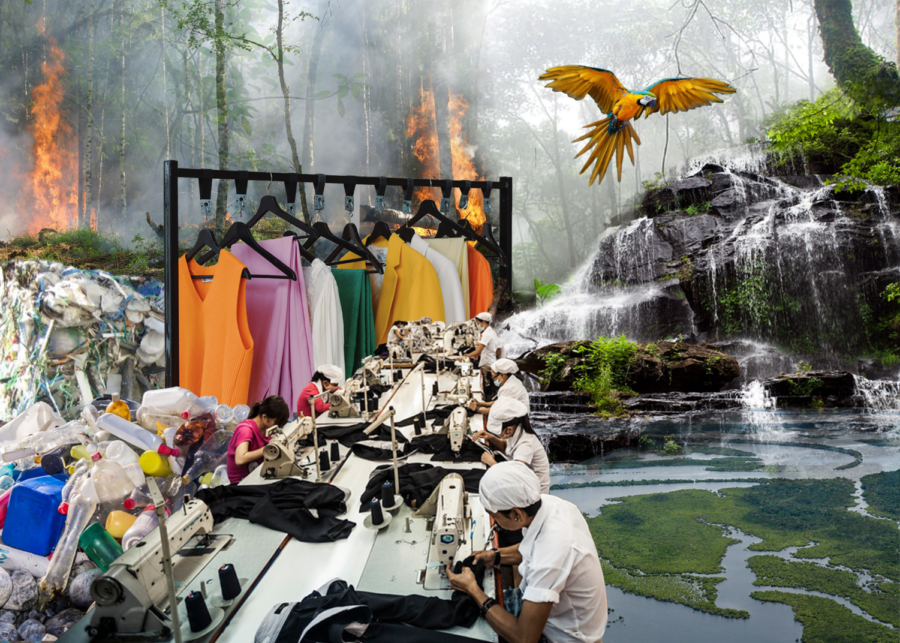The true cost of fast fashion
May 15, 2023
In this day and age, fast fashion culture has greatly influenced today’s generation. Keeping up with the trends on the catwalk has been a hassle every day due to its constant change. Fashion seasons have shortened within the past few years due to the rise of fast fashion. Fast fashion is a reflection of the trends and styles that are presented on the catwalk. While the garments on high-fashion runways are expensive, fast fashion provides consumers with a cheaper alternative to get a hand on the latest trends. The continuous production of clothing has had a negative impact on both the fashion industry and the Earth. As Generation Z crazes new trends on the runway, the environment suffers many detriments.
The price of fast fashion has dramatically impacted both the environment and the fashion industry. Fast fashion consists of cheap, low-quality garments that are produced at a high rate and increase carbon emissions and waste, which results in significant environmental damage. The production of synthetic fabrics (polyester, nylon, etc.) requires great amounts of energy and releases harmful pollutants. In addition, the disposal of fast fashion garments often involves incineration which promotes carbon emissions, or dumping in landfills which contributes to global waste. Many small, independent designers also struggle to compete with the fast fashion giants, leading to a loss of diversity and creativity in the industry.
Fast fashion is promoted because it’s cheap. Some people don’t have to think twice about what they wear on a daily basis, but that needs to change. From my perspective, it is crucial for consumers to be mindful of their purchasing habits and to consider the impact of their choices. By investing in quality, timeless pieces or choosing secondhand and sustainable options, individuals can reduce their carbon footprint and maintain ethical and sustainable practices. Furthermore, companies must take responsibility for their actions and uphold environmentally conscious production methods.
The disparity between cheap and expensive clothing is huge in the fashion industry. Cheap clothing is more often than not the resource for fast fashion, while expensive clothing is more correlated with slow fashion. The idea that you have to have money to be sustainable is so mind-boggling to me, and I would love to purchase sustainable clothing without blowing the bank. Nevertheless, secondhand clothing does offer inexpensive garments, and I believe that it’s always fun to hit the thrift store because you don’t know what you’ll find!
Influencers greatly impact what we, as consumers, purchase for our closets. Social media influencers have a huge influence on where we spend our money. In my experience, whenever I see an influencer or an individual I look up to, I turn to them for inspiration. This also leads to another idea of “a person is not their own person” but rather a copy-paste of numerous individuals combined. No person is truly an individual in this day and age because of the numerous influencers that affect our lives. It may just be my experience, but I am easily influenced when it comes to things I see someone who I look up to promote like a specific item or what they wear.
The production of garments has been at the hands of sweatshops that pay their female workers less than minimum wage. These women have been the hands that sewn fast fashion garments, and the harmful conditions in which they work have grave consequences for their health and well-being. These workers often endure long hours without adequate breaks or protective gear and are at risk of occupational injuries and illnesses. Child labor in garment production is extremely heartbreaking, as it deprives children of their right to education and exposes them to hazardous working conditions. The lack of fair labor practices in the fast fashion industry also contributes to poverty and inequality in low-income countries.
The increase of microtrends has also enlarged the fashion industry’s growing carbon footprint. As the name suggests, microtrends are short, temporary trends that typically last for two to four weeks, and these trends have shortened fashion seasons and trend time. The fashion industry has been hit hard by microtrends, and these have surged garment production in the fashion industry. Popularized by social media platforms (Instagram, TikTok, etc.), microtrends have influenced fashionistas and fashion designers. As new trends emerge on a daily basis, companies race to the production of these new products at a lowered price.
Individuals have turned to non-fungible tokens (NFTs) and digital fashion to combat the fast fashion issue. In the midst of this technological era, we have utilized NFTs as a “substitute” for fast fashion, but this option has turned to a detriment. NFTs are digital assets representing ownership of a unique item or piece of media. While NFTs offer a new way for creators to monetize their work and for collectors to own and display digital art, they are not a sustainable nor ethical solution to the fast fashion issue. The production of NFTs requires a significant amount of energy, with some estimates suggesting that a single NFT transaction can produce as many carbon emissions as a European household in a month.
But, why should we care? While the fast fashion industry is responsible for ten percent of the world’s carbon emissions, we need to understand the effects of this detrimental and ongoing issue. The negative impact of fast fashion on the environment and the people who produce our clothes cannot be overstated. We must recognize that our purchasing decisions have real-world consequences and make an effort to support sustainable and ethical practices in the fashion industry. This can include investing in higher-quality, timeless pieces, choosing secondhand or sustainable options, and holding companies accountable for their supply chains. Only by taking action and demanding change can we hope to create a more just and sustainable future for all.




